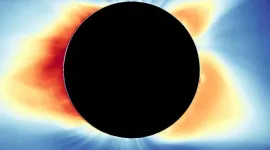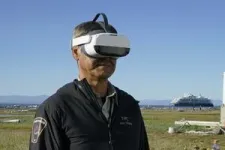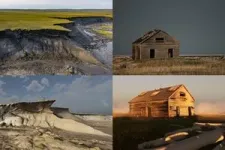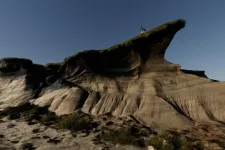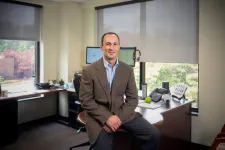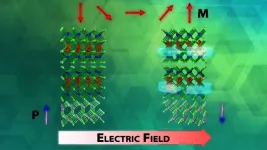(Press-News.org) A total solar eclipse will darken a swath of North America as the Moon blocks the light of the Sun for a few minutes on April 8, 2024. In addition to casting a breathtaking, passing shadow over the heads of millions of people, this total solar eclipse gives scientists a unique opportunity to study the Sun, Earth, and their interactions.
NASA will fund five interdisciplinary science projects for the 2024 eclipse to make the most of this opportunity. The projects, which are led by researchers at different academic institutions, will study the Sun and its influence on Earth with a variety of instruments, including cameras aboard high-altitude research planes, ham radios, and more. Two of the projects also encourage participation from citizen scientists.
“Seven years after the last American total solar eclipse, we’re thrilled to announce the selection of five new projects that will study the 2024 eclipse,” said Peg Luce, acting director of the Heliophysics Division in the Science Mission Directorate at NASA Headquarters in Washington. “We’re excited to see what these new experiments will uncover about our Sun and its impact on Earth.”
During total solar eclipses, the Moon perfectly blocks out the face of the Sun, allowing the Sun’s wispy outer atmosphere – called the corona – to be seen clearly.
“Scientists have long used solar eclipses to make scientific discoveries,” said Kelly Korreck, program scientist at NASA Headquarters. “They have helped us make the first detection of helium, have given us evidence for the theory of general relativity, and allowed us to better understand the Sun’s influence on Earth’s upper atmosphere.”
Chasing the Eclipse with NASA’s High-Altitude Research Planes
Using NASA’s WB-57 high-altitude research aircraft, one project will capture images of the eclipse from an altitude of 50,000 feet above Earth’s surface. By taking these images above the majority of Earth’s atmosphere, the team hopes to be able to see new details of structures in the middle and lower corona. The observations, taken with a camera that images in infrared and visible light at high resolution and high speed, could also help study a dust ring around the Sun and search for asteroids that may orbit near the Sun. The project, led by Amir Caspi at the Southwest Research Institute in San Antonio, builds on Caspi’s successful 2017 project with a new camera suite.
Airborne Imaging and Spectroscopic Observations of the Corona
NASA’s WB-57s will also fly cameras and spectrometers (which study the composition of light) to learn more about the temperature and chemical composition of the corona and coronal mass ejections, or large bursts of solar material. By flying along the eclipse path, they also hope to extend their time in the Moon’s shadow by over two minutes. The team hopes these observations will provide new insights into structures in the corona and the sources of the constant stream of particles emitted by the Sun, the solar wind. The team is led by Shadia Habbal of the University of Hawaii.
‘Listening Party’ for Amateur Radio Operators
In an upper region of our atmosphere, energy from the Sun knocks electrons out of atoms, making the region electrically charged, or “ionized.” This region, the ionosphere, can help radio communications travel long distances, such as those among amateur (or “ham”) radio operators around the world. However, when the Moon blocks the Sun during a solar eclipse, the ionosphere can change dramatically, affecting those communications.
During both the 2024 total solar eclipse and an annular solar eclipse this October, Nathaniel Frissell of The University of Scranton is inviting ham radio operators to participate in “Solar Eclipse QSO Parties,” when they will try to make as many radio contacts (“QSOs” in ham parlance) as they can with other operators in different locations. The radio operators will record how strong their signals are and how far they go to observe how the ionosphere changes during the eclipses. Similar experiments in the past have shown that changes in the ionosphere’s electron content due to solar eclipses have significant impacts on how radio waves travel.
Solar Radiation’s Effects on Earth’s Upper Atmosphere Layers
The darkest part of this eclipse’s shadow passes across several locations equipped with SuperDARN radars. The Super Dual Auroral Radar Network monitors space weather conditions in upper layers of Earth’s atmosphere, so the eclipse offers a unique opportunity to study the impact of solar radiation on upper layers of Earth’s atmosphere during the eclipse. A project led by Bharat Kunduri, of the Virginia Polytechnic Institute & State University, will use three SuperDARN radars to study the ionosphere during the eclipse. Kunduri’s team will compare the measurements to predictions from computer models to answer questions about how the ionosphere reacts to a solar eclipse.
Bringing the Sun’s Magnetic ‘Hot Spots’ Into Sharper Focus
During the upcoming eclipses, NASA’s Jet Propulsion Laboratory scientist Thangasamy Velusamy, educators at the Lewis Center for Education Research in Southern California, and participants in the center’s Solar Patrol citizen science program will observe solar “active regions” – the magnetically complex regions that form over sunspots – as the Moon moves over them. The Moon’s gradual passage across the Sun blocks different portions of the active region at different times, allowing scientists to distinguish light signals coming from one portion versus another. The team will use the 34-meter Goldstone Apple Valley Radio Telescope (GAVRT) to measure subtle changes to the radio emissions from active regions during both the 2023 annular and 2024 total eclipses. The technique, first used during the May 2012 annular eclipses, revealed details on the Sun the telescope couldn’t otherwise detect.
END
Science in the shadows: NASA selects 5 experiments for 2024 total solar eclipse
2023-06-20
ELSE PRESS RELEASES FROM THIS DATE:
Dupilumab lessens disease in COPD patients with type 2 inflammation
2023-06-20
BIRMINGHAM, Ala. – Chronic obstructive pulmonary disease patients with type 2 inflammation saw rapid and sustained improvements in their disease after treatment with the monoclonal antibody dupilumab, according to a yearlong, Phase 3 clinical trial reported in the New England Journal of Medicine.
These improvements — as measured by a significantly lower annualized rate of acute exacerbations, significantly better lung function and quality of life, and significantly less severe symptoms than placebo-treated adults with COPD — were observed within two to four weeks after the initiation of dupilumab and were sustained throughout the 52-week trial period. This monoclonal antibody ...
Scientists discover new embryonic cell type that self-destructs to protect the developing embryo
2023-06-20
Scientists studying gene activity data of the early human embryo have discovered an overlooked type of cell which self-destructs within days of forming, as part of a quality control process to protect the developing foetus. The findings give insights on what happens at the very first stages of life after fertilisation which could in the future help improve IVF or regenerative medicine treatments.
A new study published on 20 June 2023 in PLoS Biology by an international team of scientists including researchers at the University of Bath, finds that our earliest development in the womb may be rather different to what we have always assumed.
While ...
National Geographic Explorers win award for visualizing arctic climate change
2023-06-20
FOR IMMEDIATE RELEASE: June 20, 2023 - Washington, D.C. - An innovative virtual reality project created by National Geographic Explorers in collaboration with local communities was recognized with the “Best in Category: Visualize” during the XR Prize Challenge: Fight Climate Change earlier this month. The project, “Qikiqtaruk: Arctic at Risk” was selected for the award from across 150 submissions at the Augmented World Expo (AWE) in Santa Clara, California on June 1, 2023.
“Qikiqtaruk: Arctic at Risk” brought together researchers, park rangers, educators and immersive content ...
NYU Abu Dhabi researchers develop first-of-its-kind adhesive bandage that can detect COVID-19 antibodies
2023-06-20
Abu Dhabi, UAE, June 20, 2023: Researchers at NYU Abu Dhabi have developed a new rapid testing method for COVID-19 – an adhesive bandage that relies on gold nanoparticles to quickly detect the immune antibodies in the bloodstream.
These antibodies, named IgM and IgG, are naturally produced as a result of SARS-CoV-2 infection, and therefore serve as valuable biomarkers to identify infected individuals and monitor the spread of pandemics. The innovative bandage technology is affordable and easy-to-use, and ...
Alissa Park appointed Dean of UCLA Henry Samueli School of Engineering and Applied Science
2023-06-20
Ah-Hyung “Alissa” Park has been appointed the Ronald and Valerie Sugar Dean of the UCLA Henry Samueli School of Engineering and Applied Science, effective September 1.
One of the nation’s leading experts on carbon capture and conversion technology, Park is currently the Lenfest Earth Institute Professor of Climate Change and chair of the department of earth and environmental engineering at Columbia University, where she has been a faculty member since 2007. She also is director of the Lenfest Center for Sustainable Energy, an executive committee ...
Research identifies factors that make correcting misinformation about science more successful
2023-06-20
In an article titled “A Meta-analysis of Correction Effects in Science-Relevant Misinformation” published in the journal Nature Human Behaviour, University of Pennsylvania social psychologists and communication scholars Man-pui Sally Chan and Dolores Albarracín explain the circumstances under which corrections of misinformation about science are most likely to work or fail, as well as the characteristics of the corrections most likely to succeed.
The authors conducted a meta-analysis, a quantitative synthesis of prior research, which involved 60,000 ...
Wider access to health insurance via Medicaid expansion improved cardiac care
2023-06-20
Research Highlights:
States that participated in the Medicaid expansion provision of the Affordable Care Act, raising the income level to be eligible for Medicaid up to 138% of the federal poverty level, improved several measures of heart disease care for Medicaid recipients in their states.
In an analysis of 30 studies comparing states that chose to participate in Medicaid expansion with those that didn’t, Medicaid expansion was associated with improvement in insurance coverage for cardiac care, decreased out-of-hospital deaths, fewer socioeconomic and demographic disparities in care and increased preventive care and screening.
Embargoed until 1 p.m. CT/2 p.m. ET, ...
Less-invasive cardiac MRI is a valuable diagnostic tool in the early evaluation of patients with acute chest pain
2023-06-20
WINSTON-SALEM, N.C. – June 20, 2023 – An estimated 3 million patients visit emergency departments each year with acute chest pain and mildly elevated troponin levels. High levels of troponin, a protein, occur when the heart muscle is damaged from a heart attack. How best to evaluate and treat patients with chest pain with detectable or mildly elevated troponin remains unclear.
Now, a new study from researchers at Wake Forest University School of Medicine reveals that cardiac magnetic resonance imaging (MRI), is a safe and valuable tool to help evaluate these complex patients.
The ...
Novel way to manipulate exotic materials
2023-06-20
An advance in a topological insulator material — whose interior behaves like an electrical insulator but whose surface behaves like a conductor — could revolutionize the fields of next-generation electronics and quantum computing, according to scientists at Oak Ridge National Laboratory.
Discovered in the 1980s, a topological material is a new phase of material whose discoverers received a Nobel Prize in 2016. Using only an electric field, ORNL researchers have transformed a normal insulator into a magnetic topological insulator. This exotic material allows electricity ...
Research pilot sets the stage for better, more equitable aortic stenosis care
2023-06-20
DALLAS, June 20, 2023 — New research published today in Circulation: Cardiovascular Quality and Outcomes examines the pilot phase of the American Heart Association quality improvement program Target: Aortic Stenosis™. The program aims to lay the groundwork to more reliably measure performance on the quality of aortic stenosis (AS) care from diagnosis to treatment. The Target: Aortic Stenosis program focuses on closing care gaps for patients who are not appropriately diagnosed and referred for initial ...
